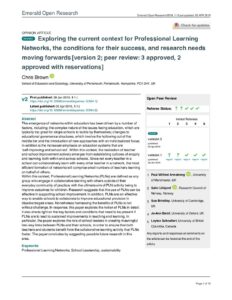The emergence of networks within education has been driven by a number of factors, including: the complex nature of the issues facing education, which are typically too great for single schools to tackle by themselves; changes to educational governance structures, which involve the hollowing out of the middle tier and the introduction of new approaches with an individualized focus; in addition is the increased emphasis on education systems that are ‘self-improving and school-led’. Within this context, the realization of teacher and school improvement actively emerges from establishing cultures of enquiry and learning, both within and across schools. Since not every teacher in a school can collaboratively learn with every other teacher in a network, the most efficient formation of networks will comprise small numbers of teachers learning on behalf of others.
Within this context, Professional Learning Networks (PLNs) are defined as any group who engage in collaborative learning with others outside of their everyday community of practice; with the ultimate aim of PLN activity being to improve outcomes for children. Research suggests that the use of PLNs can be effective in supporting school improvement. In addition, PLNs are an effective way to enable schools to collaborate to improve educational provision in disadvantaged areas. Nonetheless harnessing the benefits of PLNs is not without challenge. In response, this paper explores the notion of PLNs in detail; it also sheds light on the key factors and conditions that need to be present if PLNs are to lead to sustained improvements in teaching and learning. In particular, the paper explores the role of school leaders in creating meaningful two-way links between PLNs and their schools, in order to ensure that both teachers and students benefit from the collaborative learning activity that PLNs foster. The paper concludes by suggesting possible future research in this area.


